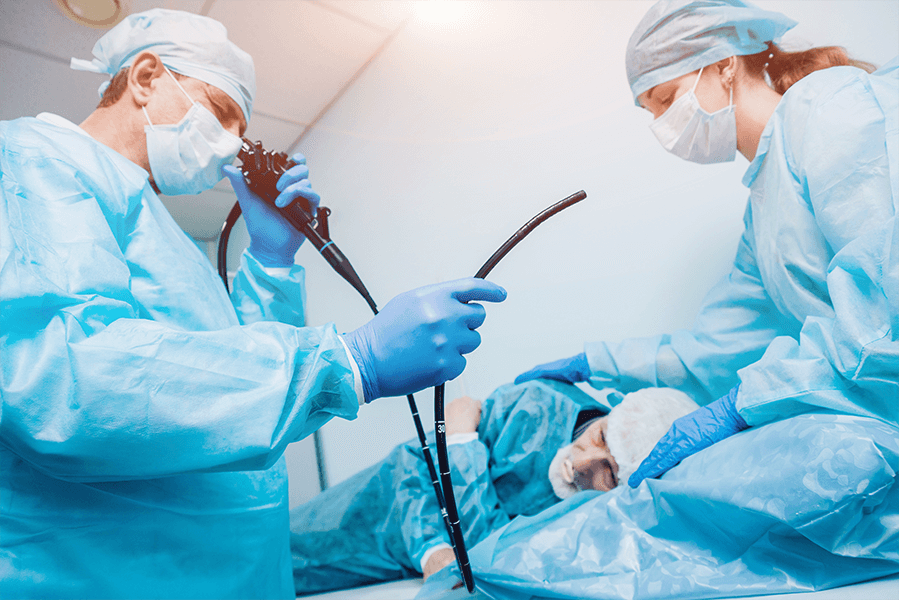What is an endoscopic ultrasound (EUS)?
An endoscopic ultrasound (EUS) is an endoscopic procedure where a long, thin, flexible tube or “scope” is placed into either the mouth, and advanced to the duodenum or into the beginning of the small intestine, or into the rectum. The scope has a light and a camera on the end of it which allows the physician to examine the lining of the esophagus, stomach, first portion of the small intestine, or the rectum. In addition to visualizing the intestine like a regular endoscope, the EUS scope also has an ultrasound probe which allows the physician to examine the gastrointestinal tract with ultrasound waves. The ultrasound waves allow the physician to examine the different layers of the intestinal wall as well as other organs within the body. An endoscopic ultrasound (EUS) may be performed to evaluate abnormalities in the wall of the intestine, or abnormalities in other organs such as the pancreas, biliary system, and chest. The EUS is often used to help stage cancer. If you have been experiencing troubling symptoms related to your GI tract, this procedure could help diagnose and begin treatment on your condition. Contact GI Alliance to learn more about this and other endoscopic procedures.

Why would I need an EUS?
There are several reasons as to why a physician could use an endoscopic ultrasound. The main reasons why you would get an endoscopic ultrasound include:
- Study of tumors or abnormalities in organs including the gallbladder and liver
- Study of nodules in the intestinal wall
- Evaluation of stages of cancer
- Evaluation of disorders of the pancreas
- Study of the muscles of the lower rectum and anal canal to discover causes of fecal incontinence
- Assessment of Barrett’s Esophagus
- Evaluation of bile duct stones
- Evaluation of sarcoidosis
What should I expect the day before my endoscopic ultrasound?
You will receive instructions from your doctor regarding the necessary preparation. Most patients will be allowed to eat normally the day before the exam. Patients will be instructed not to take anything by mouth after midnight except for medications. It is very important to follow the instructions given to you by your doctor. There will also be additional instructions regarding your medications. In most cases, your medications will be continued as usual. However, in certain circumstances, especially in patients on blood thinners (i.e. coumadin, warfarin, plavix, aspirin, anti inflammatories) and in diabetics, special instructions will be given.
What happens on the day of my endoscopic ultrasound?
You will be asked to arrive at the endoscopy center 1 to 1.5 hours before your exam. This is to allow time to fill out paperwork and prepare for the exam. You will be asked to change into a medical gown. An intravenous (IV) catheter will be started in your arm so that sedation can be administered. You will be connected to equipment that will allow the doctor and staff to monitor your heart rate, blood pressure, pulse, electrocardiogram, breathing, and oxygen level during and after the exam.
Once in the exam room, you will be asked to lie on your left side on the stretcher. The IV sedation will be started. Small amounts are given at a time to ensure that you do not have any reactions to the medication and to provide only the amount that you need individually. Once an adequate level of sedation is achieved, the endoscope will be gently inserted into the mouth. The scope will be carefully advanced through the esophagus, stomach, and first portion of the small intestine or duodenum. A small amount of air is injected through the scope into the gastrointestinal (GI) tract to help the physician see. Any fluid remaining in the upper GI tract is suctioned out through the scope. Depending on the findings of the exam, several things can be done at the time of the procedure including biopsies, removal of polyps, and control of bleeding. At the end of the procedure, as much of the air and remaining fluid as possible is suctioned out through the scope. Depending on the findings, the exam takes approximately 30-60 minutes.
After the exam is complete, the patient is taken to the recovery room to be monitored while the sedation starts to wear off. The amount of sedation used during the exam and the patient’s individual response to the medication will dictate how quickly the patient wakes up, though most patients are awake enough for discharge within 45-60 minutes. You will not be allowed to drive for the rest of the day; therefore, you will need to arrange for a ride home. You will also be instructed not to work, sign important papers, or perform strenuous activities for the rest of the day. Most patients are able to eat and drink normally after their discharge from the endoscopy unit, however, specific instructions regarding activity, eating, and medications will be given to the patient prior to discharge.
After the exam, the doctor and/or nurse will go over the findings of the procedure with you. Most patients will not remember what they are told after the exam because of the effects of the sedation. It is recommended, if possible, to bring someone with you to whom the results can, also, be discussed. The patient will also go home with a typed report. The patient will be informed of any biopsy results within one week.
What are the risks of an endoscopic ultrasound?
In general, endoscopic ultrasound (EUS) is a very safe procedure. Overall, complications occur in less than 1% of patients. Most complications are not life-threatening, however, if a complication occurs, it may require hospitalization and surgery. Prior to the exam, a consent form will be reviewed with the patient by the nursing staff. Should any questions or concerns arise, these can be discussed with your physician prior to beginning the procedure.
Medication reactions associated with the sedation can occur. These can include but are not limited to allergic reactions, difficulty breathing, effects on the heart and blood pressure, and irritation of the vein used to give the medication.
Bleeding can occur with biopsies and fine needle aspiration. Again, significant bleeding which might require a blood transfusion or hospitalization is very uncommon.
Perforation or puncture of the esophagus, stomach, small intestine, or rectum can occur. This may be recognized at the time of the exam, or it may not be apparent until later in the day. In most cases, a perforation will require surgery and hospitalization. This is an uncommon complication, even when biopsies or a fine needle aspiration are performed.
It is very important that the patient contact the doctor’s office immediately if symptoms arise after the procedure such as worsening abdominal pain, bleeding, or fever.
Like any other test, an endoscopic ultrasound (EUS) is not perfect. There is a small, accepted risk that abnormalities including cancers can be missed at the time of the exam. It is important to continue to follow-up with your doctors as instructed and inform them of any new or persistent symptoms.
What are alternatives to an endoscopic ultrasound (EUS)?
To an extent, the alternatives to the exam will depend on the reason for needing to undergo the endoscopic ultrasound (EUS) in the first place. In many cases, the endoscopic ultrasound (EUS) is the best method to evaluate and treat abnormalities in the GI tract. However, x-rays such as a CT scan, MRI, and transabdominal ultrasound can evaluate the GI tract as well. However, these are only diagnostic exams.

